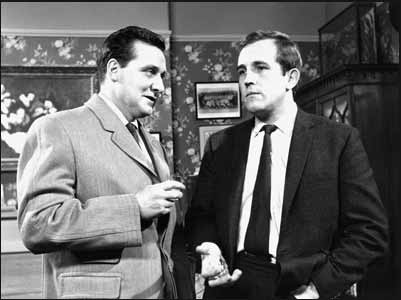|
Click here to return to the main site. The Avengers: The Missing Year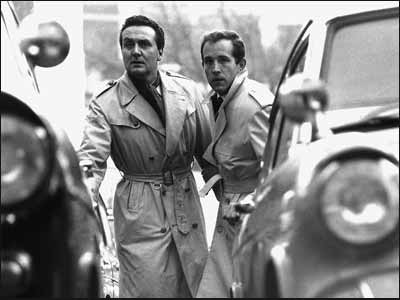 Twenty-four episodes of the British television series The Avengers are missing from the archives, all of them from the show’s first series (broadcast in 1961), starring Ian Hendry as Dr David Keel with Patrick Macnee as John Steed. Only two complete episodes from this year of the show, Girl on the Trapeze and The Frighteners, are known to exist today. Richard McGinlay explains why this should be, and what hope there is of ever experiencing these lost stories again… Nowadays, in the age of DVD and Blu-ray releases, video on demand, and countless channels showing classic (and not so classic) reruns, it can be hard to comprehend why carefully crafted productions such as The Avengers would not be preserved in their entirety. However, it is important to remember that when methods of recording television programmes were first developed, they were seen not as a means of permanent storage, but as a way to ease the process of broadcasting shows that would otherwise have had to be performed live. Prior to that point, drama and entertainment output had been very much akin to live theatre, only with cameras pointed at it. The show went out before its viewing audience, and if a further performance was required, it would have to be re-enacted. Furthermore, until the boom of the home video market in the 1980s, television tended to be regarded as an ephemeral medium, like theatre, rather than a more lasting art form, such as cinema.
Videotape recording technology was first used within the British television industry in 1958. Earlier experiments within the BBC involved a system called VERA (Vision Electronic Recording Apparatus), but this was quickly superseded by technology developed by the American company Ampex. This is the format on which The Avengers was recorded during its first three series. In those days, the process of videotape editing was almost non-existent, the only options being to stop and resume recording or to physically cut and splice the tape. Therefore, even recorded programmes were produced “as live”: that is, in story order (with any pre-filmed sequences such as location work or stock footage played in) and with as few breaks as possible. The two-inch tapes were also bulky and the technology extremely expensive. Only the fact that videotape could be recycled made the medium affordable, so tapes were routinely wiped and reused after transmission. If a programme was to be retained for any reason, such as a sale to a foreign broadcaster, then it would be transferred to film (usually 16mm) via telerecording, a fairly primitive process that involved pointing a film camera at a specially adapted video monitor. Film was less bulky than videotape and also overcame the obstacle of differing transmission standards in other countries, since most broadcasters could transmit from film. It is for these reasons that all the surviving episodes from the videotaped era of The Avengers exist as 16mm telerecordings rather than on their original videotapes. A significant proportion of missing television finds have been made in the archives of overseas broadcasters, or in the UK after films have been returned from abroad. Such is the case with the surviving 1960s episodes of the BBC science-fiction series Doctor Who, the vast majority of which are 16mm film recordings made for export. Series 2 and 3 of The Avengers were sold to Australia, where the episodes were first broadcast between October 1963 and February 1966. This would certainly explain why telerecordings were made of the Cathy Gale episodes starring Patrick Macnee and Honor Blackman, even though the surviving prints were held in Britain. The later film-era episodes, featuring Steed’s partners Emma Peel and Tara King, were preserved as a matter of course, as were almost all ITV film series, having been produced in that format with American funding and with overseas transmissions in mind.
By contrast, no Series 1 episodes aired outside the UK prior to 1998. There have been rumours of sales to Canada and New Zealand, but no documentary evidence has been found to corroborate these suggestions. This goes some way towards explaining why so little of Series 1 is still around today. The simple mathematical fact is that the greater the number of film copies made, the better the odds of an episode surviving somewhere. Even though film was safe from being wiped, it was not immune to being junked. Copyright and other rights issues have also affected the preservation of television shows. Even as recently as the 1980s, payments to freelance contributors such as writers, actors and musicians could mean that repeating an old programme was almost as expensive as making a new one. In particular, the actors’ union Equity was highly suspicious of the introduction of television recording, and was concerned that endless reruns could curtail the levels of new production, thus threatening the livelihoods of its members. The union was able to include clauses in its members’ contracts which stipulated that recordings could only be repeated a set number of times within a certain timeframe (typically two years). Overseas sales had similar restrictions placed upon them. Licence agreements with foreign broadcasters were for a limited period of time and number of screenings, after which the film prints were supposed to be returned to the original exporter, or destroyed, or sent on to another broadcaster to whom screening rights had been sold. Eventually the rights to sell an episode (as agreed with its freelance contributors) would themselves expire, reducing the film’s value as an exploitable resource. Furthermore, as television broadcasters around the world switched to colour transmission during the late 1960s and early 1970s, black and white programmes were deemed to be of lesser or no interest, and such films were frequently junked to clear shelf space.
An additional complication for the ITV network lay in its very nature, as a formation of private independent companies awarded licences to serve geographical areas for a set period. For example, Associated British Corporation (ABC), the company which produced The Avengers, ceased broadcasting under that name in July 1968, when it was merged with Rediffusion London (formerly Associated Rediffusion) to form Thames Television. Ownership and copyright of programmes remained with the respective production company rather than with the network, which meant that when a company lost its licence, its archived material (including videotapes, films and paperwork) was often sold to third parties and/or risked being destroyed. The ABC archive of Avengers material has changed hands many times over the decades, so not only have episodes gone missing, but also many photographs, scripts and other production documents. Compare this with the case of Doctor Who, the most high-profile example of a television show that has not survived in its entirety. Though 97 of its 253 episodes broadcast during the 1960s are currently not known to exist as complete programmes (compared with 24 out of 161 episodes of The Avengers), they all survive on audio, owing to the dedicated efforts of fans making off-air sound recordings at the time of transmission. Moreover, original scripts survive for all of these episodes, along with film clips of varying durations for all but three serials.
Copious images also exist for many missing Doctor Who programmes, thanks in large part to the work of professional photographer John Cura, who took off-screen “Tele-Snaps” of countless television shows during the 1940s, 1950s and 1960s. Even those stories that were not “Tele-Snapped” are represented visually in one way or another, in the form of surviving clips, or still photographs taken for reference or publicity purposes during pre-production. Even the least photographed Doctor Who stories – The Myth Makers, Mission to the Unknown and The Massacre of St Bartholomew’s Eve – each have at least a dozen authentic images to their name. By contrast, whereas multiple soundtrack recordings have allowed all of Doctor Who’s missing episodes to be released on CD, and several of them to be animated for DVD, only one missing Avengers story is believed to exist on audio: Tunnel of Fear. This recording is reputed to reside in the hands of a private collector and has not been made available for commercial release. One likely reason for this dearth of soundtrack recordings is the show’s relative lack of coverage when broadcast. Not only was Series 1 not shown overseas, but it did not air across every part of the UK, with nine episodes never having been broadcast in London. Not even all of the scripts are known to survive. Scripts have been recovered for 15 of the 24 Avengers absentees, but for the other nine – Nightmare, Crescent Moon, Diamond Cut Diamond, Hunt the Man Down, Death on the Slipway, Tunnel of Fear, The Far Distant Dead, The Deadly Air and Dragonsfield – there is little to go on apart from surviving synopses, in particular those presented by Dave Rogers in his 1989 book The Complete Avengers.
John Cura has added greatly to our knowledge of Series 1 with his Tele-Snaps of 13 missing Avengers episodes – from One for the Mortuary onwards – which were commissioned and diligently preserved by the show’s original producer Leonard White. However, most of the earlier episodes are poorly represented in visual terms. Many of them have just one or a handful of photographs to their name, while several – Nightmare, Crescent Moon, The Radioactive Man, Please Don’t Feed the Animals and Dance with Death – have none at all. Only one clip is known to survive from an otherwise missing Avengers episode, though admittedly it is a biggie: the entire first act (just over 15 minutes) of the opening instalment, Hot Snow. Both The Avengers and Doctor Who have fared rather better than many other high-profile series from around the same period. For example, two long-running BBC police dramas, Dixon of Dock Green (1955 to 1976) and Z Cars (1962 to 1978), are largely absent from the archives. From a total of 432 episodes of Dixon of Dock Green, only 32 complete episodes remain, while 465 of Z Cars’ 799 episodes are currently missing. In direct comparison to the first series of The Avengers, none of the 26 episodes of the videotaped Associated Rediffusion spy series Top Secret (1961 to 1962), starring William Franklyn, are known to exist today. For many years, the only episode believed to have survived from Series 1 of The Avengers was The Frighteners, which appears to have been held in the ABC archive as a 16mm film recording since 1961. Why this instalment alone should be preserved is something of a mystery, though the use of clips from it in an edition of This Is Your Life devoted to Ian Hendry (broadcast on 15th March 1978) and in the movie Quadrophenia (1979) does suggest that, by the late 1970s at least, The Frighteners was the only Series 1 episode available in the archive.
Further mystery surrounds the discovery of the opening act of Hot Snow and the complete episode Girl on the Trapeze on 16mm film in April 2001, not in Britain but in the USA – despite the fact that these episodes had never aired overseas. The existence of these prints was discovered when archive television enthusiast Dave Wood conducted an online search of various film and TV archives, and saw the episodes listed in a catalogue of holdings at the University of California, Los Angeles (UCLA). Quite how they ended up there is unknown. Though it may seem unlikely that any further episodes will be recovered, miracles do sometimes happen, as the case of Hot Snow and Girl on the Trapeze has proven. Nor was this an isolated incident. In common with Series 1 of The Avengers, the twelve-part Doctor Who serial The Daleks’ Master Plan was never broadcast outside the UK, but in spite of this, three of its episodes survive as 16mm film recordings. Two of these were reportedly found in the basement of a Mormon Church in South London, while the other was saved from destruction by a BBC engineer who had been tasked with clearing out a room full of “junk” in an Ealing studio. There are numerous similar instances of episodes that have found their way into private hands, despite those prints having been marked for destruction. These films can remain in private collections for many years, with the owner unaware that they may hold the last remaining copies of television programmes. Despite the lack of overseas buyers, episodes from Series 1 may have been duplicated and/or transported within British shores, from one ITV broadcaster (ABC) to another. The Avengers initially aired in just two ITV regions, ABC Midlands and ABC North. It was gradually picked up by other regions, beginning with Anglia, which joined the ABC network feed with Diamond Cut Diamond. Some regions, including ATV London, showed the opening two instalments, Hot Snow and Brought to Book, several months behind their respective ABC premieres, prior to joining the ABC network feed for Dance with Death onwards. Others joined the party even later, with the Border, Grampian and Scottish regions airing only a smattering of Series 1 episodes.
In common with Series 2 and 3, Series 1 was recorded on to and then broadcast from videotape – or, in the case of seven early episodes (Square Root of Evil to Ashes of Roses), broadcast live and videotaped from transmission. It has been widely and incorrectly assumed that the live episodes were never recorded in any way and simply vanished into the ether, though the recovery of Girl on the Trapeze has proven that at least one of them was telerecorded. Furthermore, scripts and other contemporary documentation list VTR (Video Tape Recording) numbers for all of the live shows. One particularly enticing document from 1962 proposed a “repeat” run of the nine Series 1 episodes that had not aired in London (Square Root of Evil to Please Don’t Feed the Animals). Though the proposed “replays” ultimately did not take place, the document proves that these episodes were held on videotape as late as 30th March 1962. A Change of Bait is known to have survived at least a little longer, as another memorandum reveals that it was screened to members of the Independent Television Authority (ITA) and a deputation from the Home Office on 20th June 1962, following a complaint about that story’s content. No further episodes of The Avengers have been recovered since 2001, but that does not necessarily mean that we have seen the last of Series 1. The most recent discoveries have been in terms of still images and scripts rather than complete episodes or clips.
In 2009, while preparing special features for a new DVD release of the series from Optimum Releasing / StudioCanal, Jaz Wiseman approached the original Avengers producer, Leonard White, to invite him to contribute to the range. White was greatly enthused by the idea and agreed to meet Wiseman in London to record commentary tracks. On the day the pair met, Wiseman was astonished when White showed him a set of scrapbooks that he had compiled during his time on The Avengers, which included Tele-Snaps of 13 missing episodes. White explained that the off-screen images commenced with One for the Mortuary, and not earlier, because it was only at this point that he had become aware of the Tele-Snaps service offered by John Cura. White kindly made these images available for use in the production of DVD extras. This development led to the creation of The Avengers Reconstructed, a series of narrated summaries of missing episodes accompanied by Tele-Snaps and other images, put together by Alan and Alys Hayes. Owing to script availability (or rather a lack of), the first reconstructions to be made were Double Danger and A Change of Bait. These were included as special features in the Complete Series 3 box set issued in 2010. Thanks to the generosity of fellow Avengers enthusiasts Dave Rogers and Dave Matthews, access was subsequently granted to other Series 1 scripts, including Kill the King and Dead of Winter, which became the next two episodes to benefit from the reconstruction treatment. Where Tele-Snaps but no scripts were available, shorter reconstructions (referred to as the Mission Brief strand) were produced, based upon images and previously published synopses. These had shorter running times of between seven and nine minutes, compared with the 14- to 18-minute durations of reconstructions based upon full scripts. In all, 14 missing episodes (the “Tele-Snapped” stories plus the missing portion of Hot Snow) were reconstructed and released as part of the Optimum Releasing / StudioCanal range during 2010 and 2011. Since that time, one additional script has come to light: for One for the Mortuary, which was unearthed by memorabilia collector Tim Trounce. Hopefully this will not be the last piece of the Series 1 puzzle to be rediscovered. The list of surviving Series 1 materials, in terms of scripts and images (still and moving), currently looks like this:
The stories are presented in production order, allowing you to witness the development of the Avengers concept as the series progressed. The earliest episodes have a decidedly hard-boiled quality to them, though this is always leavened by wit. We see Keel and Steed tackling some fairly down-to-earth crimes, such as drug dealing (Hot Snow), protection rackets (Brought to Book), counterfeiting (Square Root of Evil), smuggling (Diamond Cut Diamond), insurance fraud and arson (Ashes of Roses and A Change of Bait). Gradually, more idiosyncratic personalities, settings and ideas emerge. Our heroes visit the zoo in Please Don’t Feed the Animals and a funfair in Tunnel of Fear. They encounter such larger-than-life characters as the terrier-stroking Big Man in Hot Snow, the eccentric taxidermist Bernard Bourg in One for the Mortuary, and the heavily made-up Meyer in Toy Trap. Science fiction (and science fact) elements also come to the fore: the dangers of radiation in The Radioactive Man, germ warfare in The Yellow Needle and The Deadly Air, spacesuits in Dragonsfield, and cryogenics in Dead of Winter. Now you can read how Keel brought his fiancée’s killer to book, what Steed discovered in the tunnel of fear, how Keel tracked down a radioactive man, how Steed survived a dance with death, and how together they became the Avengers. This feature is an extract from The Strange Case of the Missing Episodes, published by Hidden Tiger.
Return to... |
|---|
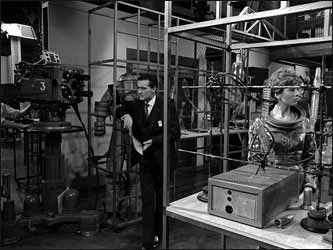
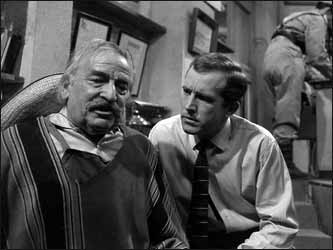
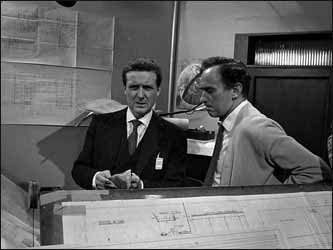
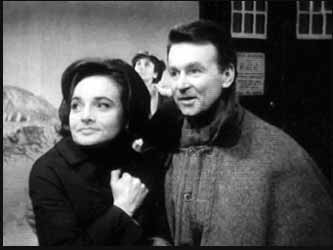

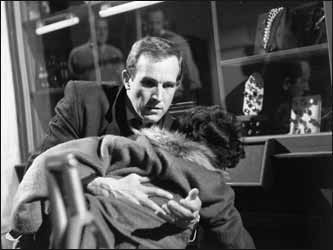
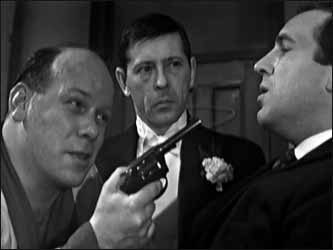
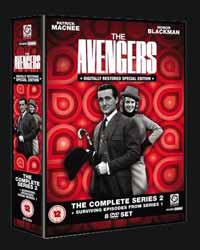
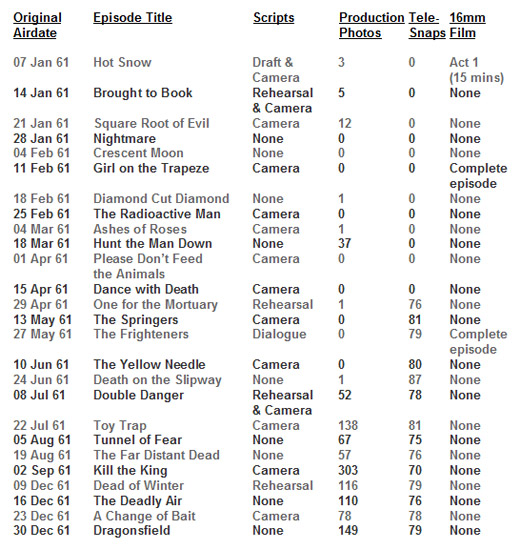
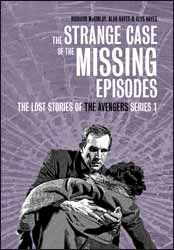 The above materials have been used as the basis of a new book, The Strange Case of the Missing Episodes, co-authored by me and Alan and Alys Hayes. The aim of the book is to present the lost stories of Series 1 in as consistent, entertaining and readable a manner as possible. For episodes for which scripts survive, there is a full story synopsis, with dialogue extracts from the script. Where no scripts are available, we have expanded existing synopses as much as possible, gleaning additional information from other sources, such as Tele-Snaps, production stills, newspaper reports and memoirs.
The above materials have been used as the basis of a new book, The Strange Case of the Missing Episodes, co-authored by me and Alan and Alys Hayes. The aim of the book is to present the lost stories of Series 1 in as consistent, entertaining and readable a manner as possible. For episodes for which scripts survive, there is a full story synopsis, with dialogue extracts from the script. Where no scripts are available, we have expanded existing synopses as much as possible, gleaning additional information from other sources, such as Tele-Snaps, production stills, newspaper reports and memoirs.